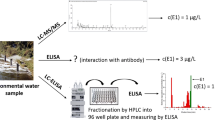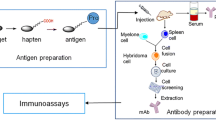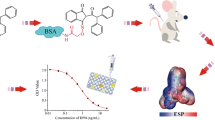Abstract
An indirect competitive enzyme-linked immunosorbent assay (IC-ELISA) has been developed for detecting estrogen molecules in environmental samples. For generating anti-estrogen monoclonal antibody (mAb), BALB/c mice were immunized with 17-estra-diol (E2)-BSA and 5760 hybridoma cell lines were established. Through the optimization processes, a mAb(4BSA-e 3C11) and estriol(E3)-BSA were finally selected as a primary antibody and a coating antigen, respectively. The IC50 value for a standard estrogen (17β-E2) was 6.26 ng mL− and the detection range (20–80% B/B0) was 0.01–377.92ng mL−. The developed IC-ELISA showed some cross-reactivities (CRs) to various estrogen analogues, such as estrone (E1) (1.79%), E3(77.34%), 16-epiestriol(27.54%) and 16 keto-17β-E2(2.02%). On the other hand, the assay showed a negligible CRs to other steroid hormones (CR5<0.063%), suggesting the specificity of the assay to estrogen molecules. For assay validation, the developed IC-ELISA was compared side by side with high performance liquid chromatography (HPLC), which showed no significant difference in their performances between the two methods. The sensitivity of our IC-ELISA was approximately 100 fold higher than that of HPLC. The estrogen contents (Estrogen Equivalent Concentrations; EEC) in field samples were determined using the IC-ELISA, including swine sewage effluents (7.043 ± 0.023 ng-EEC mL−1), bovine feces (0.013±0.001 ng-EEC mL−1), and avian feces (0.017±0.001 ng-EEC mL−). Conclusively, we have developed an IC-ELISA that is highly sensitive to estrogens as well as can detect various estrogen analogues at the same time. This assay can be used as a primary screening for a large number of field samples before the instrumental analysis that is laborintensive and time-consuming.
Similar content being viewed by others
References
IARC, Intemational Agency for Research on Cancer. vol. 21, World Health Crganization, Lyon, France. p. 279(1979).
Allen, Y.et al. Survey of estrogenic activity in United Kingdom estuarine and coastal waters and its effects on gonadal development of the flounder Platichthys flesus.Environ. Toxicol. Chem. 18, 1791–1800 (1999).
Desbrow, C., Routledge, E. J., Brighty, G. C., Sumpter, I. P. & Waldock, M. Identification of estrogenic chemicals in STW effluent. 1. Chemical fractionation and in vitro biological screening.Environ. Sci. Technol. 32, 1549–1558 (1998).
Council of the European Communities. Council Directive, EC/96/22, Cfficial Journal of European Communities; Legis L125, p. 3 (1996).
Hertz, R. Steroid-induced, steroid-producing and steroid-responsive tumors.Curr. Top. Mol. Endocrinol. 4, 1–14 (1976).
Verbeke, R.et al. Quality of the meat after the application of anabolic agents in young calves.Environ. Qual. Saf. 5, 123–130 (1976).
European Commission, Report of the Proceedings 2–4 December, Weybridge, UK, Report EUR 17549, 125 (1996).
Colborn, T., Vom Saal, F. S. & Soto, A. M. Developmental effects of endocrine-disrupting chemicals in wildlife and humans.Environ. Health Perspect. 101, 378–384(1993).
Nash, J. P.et al. Long-term exposure to environmental concentrations of the pharmaceutical ethynylestradiol causes reproductive failure in fish.Environ. Health Perspect. 112, 1725–1733 (2004).
Salazar, K. D., Miller, M. R., Brmett, J. B. & Schafer, R. Evidence for a novel endocrine disruptor: The pesticide propanil requires the ovaries and steroid synthesis to enhance humoral immunity.ToxicoL Sci. 93, 62–74 (2006).
Tanaka, H., Yakou, Y., Takahashi, A., Higashitani, T. & Komori, K. Comparison between estrogenicities estimated from DNA recombinant yeast assay and from chemical analyses of endocrine disruptors during sewage treatment.Water Sci. Technol. 43, 125–132 (2001).
Lee, H. B. & Liu, D. Degradation of 17-β-Estradiol and its metabolites by sewage bacteria.Water Air Soil Pollut. 134, 353–368 (2002).
Fujii, K., Kikuchi, S., Satomi, M., Ushio-Sata, N. & Morita, N. Degradation of 17β-estradiol by a gramnegative bacterium isolated from activated sludge in a sewage treatment plant in Tokyo, Japan.Appl. Environ. Microbiol. 68, 2057–2060 (2002).
Nasu, M., Goto, M., Kato, H., Oshima, Y. & Tanaka, H. Study on endocrine disrupting chemicals in wastewater treatment plants.Water Sci. Technol. 43, 101–108 (2001).
Huang, C. H. & Sedlak, D. L. Analysis of estrogenic hormones in municipal wastewater effluent and surface water using enzyme-linked immunosorbent assay and gas chromatogniphy/tandem mass spectrometry.Environ. Toxicol. Chem. 20, 133–139 (2001).
Fawell, J. K., Sheahan, D., James, H. A., Hurst, M. & Scott, S. Oestrogens and oestrogenic activity in raw and treated water in Severn Trent Water.Water Res. 35, 1240–1244 (2001).
Kase, R.et al. Integral assessment of estrogenic potentials in sediment-associated samples: Part 2: Study of estrogen and anti-estrogen receptor-binding potentials of sediment-associated chemicals under different salinity conditions using the salinity-adapted enzyme-linked receptor assay.Environ. Sci. Pollu. Res. Int. 15, 75–83 (2008).
Kyrein, H. I. The radioimmunoassay for steroid hormones-Part II: development and application of radioimmunoassay.Z Lebensm-Unters Forsch 177, 426–438 (1983).
Hendriks, L.et al. Matrix effects in the radioimmunoassay of esiradiol and testosterone in plasma of veal calves and how to avoid them.Anal. Chim. Acta 275, 113–122 (1993).
Hoffmann, B., Goes De Pinho, T. & Schuler, G. Determination of free and conjugated oestrogens in peripheral blood plasma, feces and urine of cattle throughout pregnancy.Exp. Clin. Endocrinol. Diabetes 105, 296–303 (1997).
Korenman, S. G., Stevens, R. H. & Carpenter, L. A. Estradiol radioimmunoassay without chromatography: procedure, validation and normal values.J. Clin. Endocrinol. Metab. 38, 718–720 (1974).
Sarmah, A. K., Northcott, G. L., Leusch, F. D. L. & Tremblay, L. A. A survey of endocrine disrupting chemicals (EDC5) in municipal sewage and animal waste effluents in the Waikato region of New Zealand.Sci. of the Total Environ. 355, 135–144 (2006).
Galfrè, G. & Milstein, C. Preparation of monoclonal antibodies: strategies and procedures.Meth. Enzymol. 73, 3–46 (1981).
Goding, J. W. Antibody production by hybridomas.J. Immunol. Meth. 39, 285–308 (1980).
Murakami, H.et al. Growth of hybridoma cells in serum-free medium: ethanolamine is an essential component.Proc. Natl. Acad. Sci. USA 79, 1158–1162 (1982).
Hansiselman, T. A., Graetz, D. A., Wilkie, A. C., Szabo, N. J. & Diaz, C. S. Determination of steroidal estrogens in flushed dairy manure wastewater by gas chromatography-mass spectrometry.J. Environ. Qual. 35, 695–700 (2006).
Lomax, D. P., Roubal, W. T., Moore, J. D. & Johnson, L. L. An enzyme-linked immunosorbent assay (ELISA) for measuring vitellogenin in English sole (Pleuronectes vetulus): Development, validation and cross-reactivity with other pleuronectids.Comp. Biochem. Physiol. B Biochem. Mol. Biol. 121, 425–436 (1998).
Weiler, E. W., Kruger, H. & Zenk, M. H. Radioimmunoassay for the determination of the steroidal alkaloid solasodine and related compounds in living plants and herbarium specimens.Planta Med. 39, 112–124 (1980).
Goda, Y.et al. Development of the ELISAs for detection of hormone-disrupting chemicals.Water Sci. and Tech. 42, 81–88 (2000).
Li, Z., Wang, S., Lee, N. A., Allan, R. D. & Kennedy, I. R. Development of a solid-phase extraction-Enzyme-linked immunosorbent assay method for the determination of estrone in water.Analytica. Chimica. Acta 503, 171–177 (2004).
Pu, C., Wu, Y.-F., Yang, H. & Deng, A.-P. Trace analysis of contraceptive drug levonorgestrel in wastewater samples by a newly developed indirect competitive enzyme-linked immunos orbent assay (ELISA) coupled with solid phase extraction.Analytica Chimica Acta 628, 73–79 (2008)
Author information
Authors and Affiliations
Corresponding author
Rights and permissions
About this article
Cite this article
Cha, M., Sohn, Et., Jung, ES. et al. Development of novel IC-ELISA as a primary high throughput screening for various estrogen molecules. Toxicol. Environ. Health. Sci. 2, 50–59 (2010). https://doi.org/10.1007/BF03216513
Accepted:
Issue Date:
DOI: https://doi.org/10.1007/BF03216513




